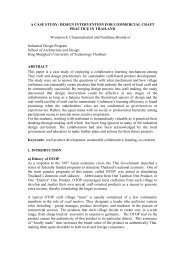soa+d research manual - School of Architecture and Design, KMUTT
soa+d research manual - School of Architecture and Design, KMUTT
soa+d research manual - School of Architecture and Design, KMUTT
Create successful ePaper yourself
Turn your PDF publications into a flip-book with our unique Google optimized e-Paper software.
suggest, however, that you fall back on your pr<strong>of</strong>essional<br />
skills as designers, artists, communicators <strong>and</strong> educators. The<br />
presentation is like a mini-lecture. Deploy the same techniques<br />
you would use to attract, sustain the interest <strong>of</strong> <strong>and</strong> inform your<br />
students <strong>and</strong> things should go well.<br />
One particular issue that might be worth thinking through,<br />
however, is the use <strong>of</strong> redundancy to increase comprehension.<br />
Redundancy simply means making the same (or similar) point<br />
in multiple ways at the same time using different sensory<br />
channels; reading <strong>and</strong> listening, for example. The theory is that<br />
redundantly coded messages are more effective because a<br />
failure to get one part <strong>of</strong> them is compensated for by another.<br />
many road signs, for example, make redundant use <strong>of</strong> colour,<br />
shape, images <strong>and</strong> words to reinforce their message. The use<br />
<strong>of</strong> spoken <strong>and</strong> visible language (projected text) is, <strong>of</strong> course<br />
common in presentations. some <strong>research</strong>ers argue, however,<br />
that this strategy is particularly important for multi-lingual<br />
audiences who may be more pr<strong>of</strong>icient in reading that listening<br />
(or vice versa). Whatever the case, there is something to be said<br />
for using more text than bullet points at times like these. give<br />
the audience something to read or see whilst they listen.<br />
PRESENTATIONAL MEDIA<br />
These days there is little choice here. most conferences expect<br />
you to produce a Powerpoint. many require it. is this a good<br />
thing? Well, nobody—apart perhaps from bill gates—planned<br />
it that way. There is, however, plenty <strong>of</strong> critical discussion about<br />
the malign impact that Powerpoint has had on the way in which<br />
we communicate <strong>and</strong> encounter knowledge. if you are interested<br />
you might looks at the musician <strong>and</strong> artist David byrne’s work<br />
that subverts the ideology <strong>of</strong> Powerpoint whilst celebrating its<br />
creative <strong>and</strong> communicative potential (http://www.davidbyrne.<br />
com/art/eeei/)<br />
TO READ OR NOT TO READ?<br />
i have already alluded to the this challenge above. Put simply, do<br />
you prepare a script <strong>and</strong> read it or adopt a more conversational<br />
tone? This is a difficult <strong>and</strong> sensitive question. On the one h<strong>and</strong>,<br />
a prepared script is, perhaps, the safest way to deliver your<br />
presentation. you can draft, preview <strong>and</strong> hone it prior to the<br />
presentation. This can help calm nerves <strong>and</strong> build confidence. On<br />
the other, ‘read’ papers can be extremely dry <strong>and</strong>, frankly, boring<br />
for your audience. On the other, a presentation improvised<br />
around your slides is a risk for all but the most experienced<br />
presenters. finding a middle way that suits you is essential.<br />
REsEARch NOTEs<br />
29<br />
some alternatives. memorise a script. forget it, it’s like<br />
reading from the paper only weirder (unless you are a really<br />
good performer). memorise the argument <strong>and</strong> express it in a<br />
conversational way on the day. better, but how? 1) go from<br />
paper to rough draft <strong>of</strong> what you want to say. go from there to<br />
index cards <strong>and</strong> from there to the design <strong>of</strong> your slides. 2) Rough<br />
draft the presentation by sketching text <strong>and</strong> image on index<br />
cards (the advantage <strong>of</strong> both the above is that you can quickly<br />
<strong>and</strong> easily add, subtract, reorder the material.) 3) Again using<br />
index cards, prepare a small set (one per slide) that contains<br />
bullet points, key words <strong>and</strong> important phrases. briefly glance<br />
at these whilst the audience peruses your slide (the advantage<br />
<strong>of</strong> this is that it builds in pauses to your presentation <strong>and</strong> gives<br />
you <strong>and</strong> the audience time to think). 4) <strong>Design</strong> memory aides into<br />
the slides. Obvious, that’s what Powerpoint is for. Well yes. but<br />
by creatively thinking about how you combine word <strong>and</strong> image,<br />
how you diagram your ideas, you can produce interesting visuals<br />
that simultaneously deliver for your audience <strong>and</strong> support your<br />
presentation.<br />
ON THE DAY<br />
common sense. get there early. load your presentation onto the<br />
computer or make sure that the connection to your own works.<br />
Try to meet with the session chairperson to introduce yourself<br />
<strong>and</strong> your work. make sure that they know who you are (name,<br />
institution, paper title etc.). make sure that your presentation<br />
contains contact details front <strong>and</strong> back. Take your business<br />
cards. have some extra copies <strong>of</strong> the paper to distribute. Present<br />
to your audience. make eye contact. Pause. speak clearly.<br />
common sense, yes. Easy to do, no.



